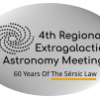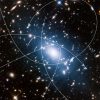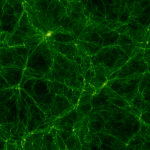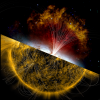The Instituto  de Astronomía Téorica y Experimental (IATE) es un instituto de investigación científica dependiente del Consejo Nacional de Investigaciones Científicas y Técnicas (CONICET) and the Universidad Nacional de Córdoba (UNC). The headquarters of the institute are located at the Observatorio Astronómico de Córdoba. The staff of the institute carry out research in astrophysics, both from an observational and theoretical point of view. Objects are studied on scales ranging from that of the objects in our solar system to the largest structures in the Universe.
de Astronomía Téorica y Experimental (IATE) es un instituto de investigación científica dependiente del Consejo Nacional de Investigaciones Científicas y Técnicas (CONICET) and the Universidad Nacional de Córdoba (UNC). The headquarters of the institute are located at the Observatorio Astronómico de Córdoba. The staff of the institute carry out research in astrophysics, both from an observational and theoretical point of view. Objects are studied on scales ranging from that of the objects in our solar system to the largest structures in the Universe.
At the IATE, there are Ph.Ds in the researcher career of CONICET, Ph.D and postdoctoral fellows, members of the support staff career of CONICET, contract staff, and Ph.D working at the institute.
IATE also stands out for the characterization of sites for the installation of great astronomical facilities in Argentine territory and of various activities that extend our research to society as a whole.
Press Releases
 Se realizó una nueva edición de la Friends of Friends meeting - Del 8 al 12 de abril del 2024 se llevó a cabo la XIII edición de la reunión “Friends of Friends Meeting” (FoF-2024) organizada en conjunto entre el Instituto de […]
Se realizó una nueva edición de la Friends of Friends meeting - Del 8 al 12 de abril del 2024 se llevó a cabo la XIII edición de la reunión “Friends of Friends Meeting” (FoF-2024) organizada en conjunto entre el Instituto de […] Julio Fernando Navarro is distinguished with the Doctor Honoris Causa of the UNC - El 4 de diciembre se reconocerá la trayectoria de este investigador que realizó sus estudios de grado y posgrado en la FaMAF y el IATE. El Dr. Navarro recibirá el […]
Julio Fernando Navarro is distinguished with the Doctor Honoris Causa of the UNC - El 4 de diciembre se reconocerá la trayectoria de este investigador que realizó sus estudios de grado y posgrado en la FaMAF y el IATE. El Dr. Navarro recibirá el […] Reconocimiento del Concejo Deliberante de la Ciudad de Córdoba a una reunión científica organizada por el IATE - La “IV Reunión Regional de Astronomía Extragaláctica: 60 años de la Ley Sersic” recibió el beneplácito el pasado 9 de noviembre. La Reunión, organizada por el IATE, sigue con […]
Reconocimiento del Concejo Deliberante de la Ciudad de Córdoba a una reunión científica organizada por el IATE - La “IV Reunión Regional de Astronomía Extragaláctica: 60 años de la Ley Sersic” recibió el beneplácito el pasado 9 de noviembre. La Reunión, organizada por el IATE, sigue con […] Reconocimiento de la Asociación Argentina de Astronomía a un investigador del IATE - Diego García Lambas recibió hoy el premio Jorge Sahade a la Trayectoria, una de las máximas distinciones que otorga la comunidad Astronómica en la Argentina. Esta distinción se […]
Reconocimiento de la Asociación Argentina de Astronomía a un investigador del IATE - Diego García Lambas recibió hoy el premio Jorge Sahade a la Trayectoria, una de las máximas distinciones que otorga la comunidad Astronómica en la Argentina. Esta distinción se […] Details of the evolution of "backsplash" galaxies unravelled - Un estudio liderado por un equipo del Instituto de Astronomía Teórica y Experimental (IATE), mediante simulaciones computacionales, explica la transformación que sufren aquellas galaxias que ingresan a un cúmulo y […]
Details of the evolution of "backsplash" galaxies unravelled - Un estudio liderado por un equipo del Instituto de Astronomía Teórica y Experimental (IATE), mediante simulaciones computacionales, explica la transformación que sufren aquellas galaxias que ingresan a un cúmulo y […]








